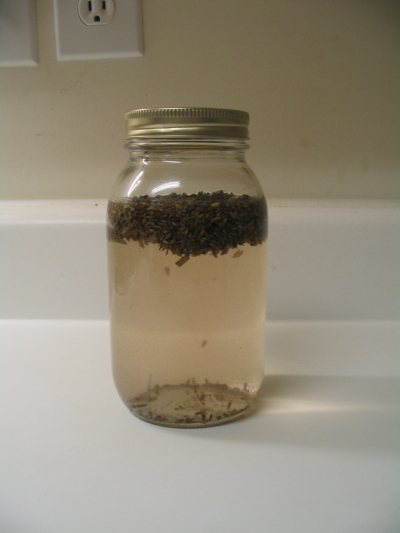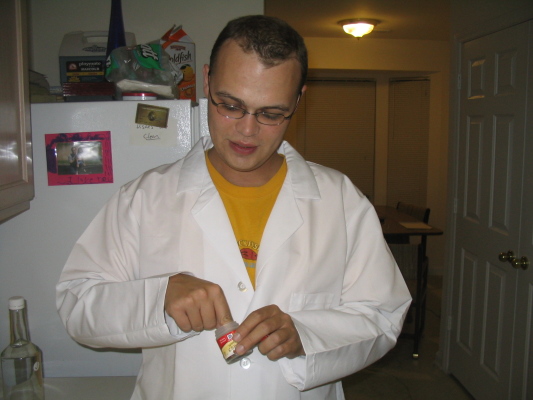Before we begin, we want to note that all comments on the blog site now require a "captcha" word verification. We've been getting a lot of spam posted in the comments - mostly in old posts, but it still needs to be stopped. It's important to us that all of our legitimate readers are able to comment, so we decided this was the best compromise. Sorry about the inconvenience.
Recently, our friend Bevin (who you might remember from our original caramel vodka experiment) had a birthday, and she had a special request for the occasion: lavender-vanilla vodka. We were only happy to oblige.
We have, of course, infused many batches of vanilla vodka in the past; it is one of our staples. However, we hadn't any idea how to proceed with the lavender. A number of websites our research uncovered recommended using whole lavender sprigs, but Bevin had provided us with a bag of loose blossoms, so we kept looking. We nearly decided to figure it out on our own, by tasting it daily until it was done; however, at the last minute, we found a post on a forum stating that such an infusion would be complete in a mere fifteen minutes, and any more would ruin it. We tested this theory using half a cup of lavender blossoms soaked in 750 mL of vodka.

The color began to change almost immediately, and sure enough, after a mere 15 minutes, the vodka had attained a light purple color and a strong but subtle aroma. We strained the blossoms out and tasted the lavender vodka without the second ingredient.
Both of us found the vodka to be subtly pleasant. "I had no idea what lavender tastes like or is even used for; I am a man, after all," I wrote in my notes. "But this vodka is very intriguing. It has a slight sweetness, and a complexity that is rare in many infusions that run for days or weeks. It has a very slight vodka flavor in the background, but no burn at all. I look forward to tasting it with the vanilla component."
"I do believe this is what lavender essential oil would taste like," Wayland wrote. "If my guess is correct, the lavender only changes the vodka flavor slightly, but it is the scent of the lavender that gives you the distinct taste."
Wayland tested his theory by tasting the vodka again, this time with his nose pinched to block the aroma.

"There was no flavor to the vodka this time... until I let go of my nose on the back end. Then it tasted like it smells again. To me, that proves that the taste comes mostly from the scent."
At this point, we sliced a vanilla bean lengthwise and placed it in the vodka as we have so many times before. We usually run vanilla vodka for about five days, though we felt that this may be too long for this infusion; we wanted a subtle vanilla flavor that would not overpower the lavender. We set out to taste it in two or three days. However, a series of unfortunate events prevented this from happening, and soon we found ourselves nearly a week into the experiment.
Fearing that the vodka must be ruined, and with Bevin's birthday fast approaching, I frantically began a second batch of vodka using the same steps. The next day, we tasted both batches for the first time; one after seven days of vanilla infusion (on the left, below), the other with a mere 24 hours.

The second batch was still close to the pleasant color of plain lavender vodka, while the original batch looked more like plain vanilla vodka. We granted the point to batch two in this round, but the most important test was yet to come.
We tasted the original (week-long) infusion first. "This has a nice blend between lavender and vanilla, I think," wrote Wayland. "My only complaint is a mild burn on the back end."
"I was surprised that the vanilla had not overpowered the lavender," I echoed. "In fact, the vanilla is a fairly light component of this vodka, though it does have a significant presence. There is still a hint of vodka flavor that detracts slightly, but not much."
Next, we sampled the second batch, with the day-long vanilla infusion. Not entirely surprisingly, this was not long enough. "The vanilla component is still there," I said, "but it's even lighter than before, essentially an afterthought. This vodka is good, but it's not much different from the straight-up lavender."
Wayland's comments were similar. "This wasn't as good as the first. The lavender flavor is a bit too overwhelming. I think, like the first, the vanilla needs more time to infuse." Then he made fun of me for panicking.

In the end, we gave both batches to Bevin, mainly so she could estimate what the plain lavender vodka would taste like using the second batch. We were quite pleased with how the first batch turned out, and may make another bottle of it for our own stock.



